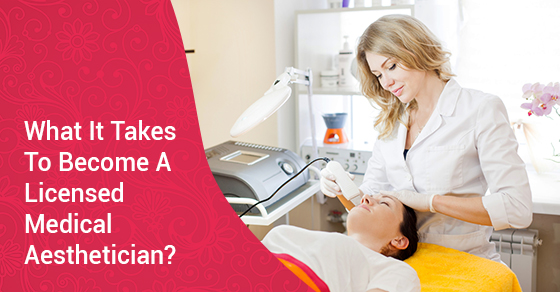The duties of a medical aesthetician are closely associated with those of a conventional spa aesthetician, and involve many of the same tactics for developing and maintaining healthy, beautiful facial skin. However, a medical aesthetician works with patients following facial surgery and trauma, in a clinical setting, and alongside medical professionals.
Common treatments include peels, masks, scrubs, massages, cleaners, creams, lotions, depilatories and laser hair removal, and other non-invasive skin care procedures recommended for medical or cosmetic purposes.
Do Medical Aestheticians Need to Be Licensed?
Like spa aestheticians, medical aestheticians are required to obtain a license from the province where they intend to work. To qualify for the province-issued license, you must follow these steps:
- Complete a recognized medical aesthetics course – Start by enrolling in an aesthetics program that is recognized by the accrediting body. Consider the requirements for each province or territory, with regard to the minimum number of hours for practical lessons and the total program hours. Most programs offer classroom education, clinical experience sessions in a student salon setting, and specific guidance and instruction to successfully pass the exam.
- Satisfy the exam requirements for provincial licensure – The basic exam requirements include a set age limit (16-18), minimum level of education (10th grade or high school diploma), and a written exam testing scientific concepts and aesthetics practices.
Even after your obtain your license, it is important to pursue advanced credentials via continuing education.
Where Can a Medical Aesthetician Work?
Although the profession uses the term “medical,” aestheticians specialising in the medical field are not required to obtain any kind of medical training. Instead, they apply conventional, complementary and alternative treatments under the supervision of different licensed health care professionals depending on the setting, which may include:
- Medical Spas – Besides the standard aesthetics treatments you would expect in a traditional spa, medical estheticians also perform specialised treatments to reduce hyperpigmentation and scarring.
- Dermatology Clinic – The medical aesthetician needs proper understanding of skin diseases such as acne, psoriasis, and atopic dermatitis.
- Cosmetic Surgery Clinics – The medical aesthetician provides pre- and post-surgery care for patients, including wound care and lymphatic drainage.
- Specialist Clinics and Units – The medical aesthetician works with cancer and trauma patients, as well as burn survivors, with treatments focused on restoring elasticity to damaged skin tissue and applying makeup to help restore the patient’s confidence.
Working as a medical aesthetician is truly fulfilling, as you are helping post-trauma patients realize a renewed level of assurance and confidence following an appearance-changing procedure or injury. Every day, you work to make a positive difference in the lives of your patients, and earn a decent living while you do it.


